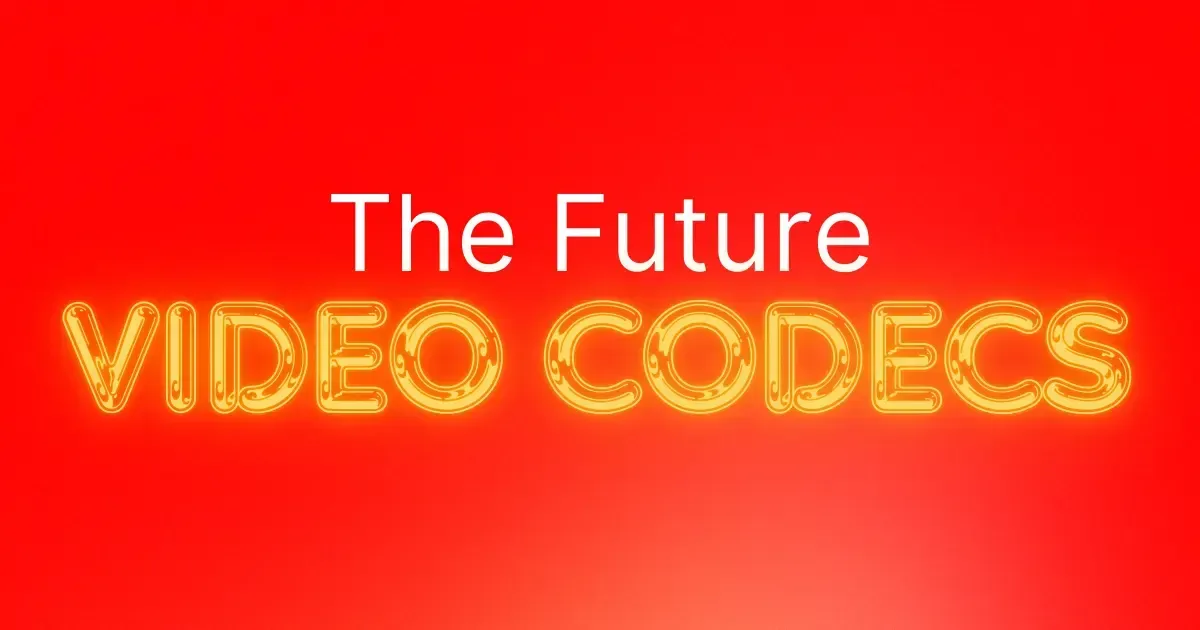The landscape of web video is constantly evolving, driven by the ever-increasing demand for high-quality, efficient video delivery across a multitude of devices and network conditions. In this post, we'll explore the cutting-edge codecs and technologies that are set to revolutionize web video in the coming years.
Emerging Video Codecs
1. AV1 Advancements
While AV1 is already making waves, its development continues at a rapid pace:
- Enhanced Efficiency: Ongoing optimizations are improving AV1's compression efficiency and encoding speed.
- Hardware Adoption: More devices are integrating hardware-based AV1 encoding and decoding, boosting performance.
- Streaming Integration: Major platforms like YouTube and Netflix are expanding their use of AV1 for streaming.
2. VVC (Versatile Video Coding)
Also known as H.266, VVC is positioned as the successor to HEVC:
- Compression Gains: VVC aims to reduce bit rates by 50% compared to HEVC while maintaining the same visual quality.
- 8K and Beyond: Designed to efficiently handle ultra-high-resolution video, including 8K and 16K.
- Versatility: Supports a wide range of applications, from mobile streaming to broadcast TV.
3. EVC (Essential Video Coding)
EVC is designed to offer a balance between performance and licensing complexity:
- Dual-Layer Approach: Offers a royalty-free base layer and a enhanced layer with optional tools.
- Competitive Efficiency: Aims to provide compression efficiency similar to HEVC.
- Simplified Licensing: Designed to avoid the licensing issues that have hindered HEVC adoption.
AI-Powered Video Compression
Artificial Intelligence is set to play a significant role in the future of video compression:
1. Neural Network Compression
- Content-Aware Compression: AI models analyze video content to apply optimal compression strategies for different types of scenes.
- Perceptual Optimization: Neural networks trained on human visual perception can make better decisions about what details to preserve or discard.
2. Super-Resolution
- AI Upscaling: Machine learning models can intelligently upscale lower-resolution video, potentially allowing for more efficient storage and transmission of video content.
- Detail Enhancement: AI can add realistic details to video, improving perceived quality.
8K and Beyond
As display technologies advance, video codecs are evolving to handle higher resolutions efficiently:
- Efficient 8K Encoding: New codecs are being optimized for 8K content, balancing quality and bitrate.
- Adaptive Streaming for High Resolutions: Advanced techniques for delivering the right resolution based on device capabilities and network conditions.
- Content-Aware Encoding: Adjusting compression levels dynamically based on the complexity of different scenes within 8K content.
Variable Frame Rate (VFR) and High Frame Rate (HFR)
The future of web video isn't just about resolution; frame rates are evolving too:
Variable Frame Rate (VFR)
- Efficiency Gains: VFR allows for adapting the frame rate to the content, reducing bandwidth for static scenes.
- Improved Mobile Experience: VFR can help conserve battery life on mobile devices by reducing decoding workload when possible.
High Frame Rate (HFR)
- Smoother Motion: HFR content (e.g., 120fps) provides ultra-smooth playback for sports and action content.
- VR and AR Applications: HFR is crucial for reducing motion sickness in virtual and augmented reality experiences.
- Codec Challenges: New codecs are being designed to handle HFR content efficiently.
HDR and Wide Color Gamut
As displays improve, video technologies are evolving to take full advantage of their capabilities:
- HDR10+: An open standard that adds dynamic metadata to HDR10, allowing for frame-by-frame optimization.
- Dolby Vision: A proprietary HDR format that offers 12-bit color depth and dynamic metadata.
- Hybrid Log-Gamma (HLG): A royalty-free HDR standard that's backwards-compatible with SDR displays.
- Rec. 2020 Color Space: Wider color gamut for more vivid and realistic color reproduction.
WebRTC and Real-Time Video Compression
The future of web-based real-time communication is being shaped by several advancements:
- AV1 for WebRTC: Implementing AV1 in WebRTC for improved quality in video calls and conferences.
- Scalable Video Coding (SVC): Allowing for graceful quality degradation in poor network conditions.
- AI-Enhanced Real-Time Processing: Using machine learning for background replacement, noise suppression, and video enhancement in real-time.
Challenges and Considerations
While these advancements are exciting, they come with challenges:
- Computational Demands: More complex codecs require more processing power, which can be challenging for mobile devices.
- Backwards Compatibility: Ensuring new technologies work with existing systems and older devices.
- Standardization: The need for industry-wide agreement on standards to prevent fragmentation.
- Content Protection: Evolving DRM technologies to work with new codecs and streaming methods.
- Energy Efficiency: Balancing improved video quality with the need for energy-efficient playback, especially on mobile devices.
Preparing for the Future
As a web developer or content creator, here are steps you can take to prepare for these emerging technologies:
- Stay Informed: Keep up with the latest developments in web video technologies and standards.
- Experiment Early: Test new codecs and technologies as they become available in browsers and devices.
- Adaptive Approach: Implement adaptive streaming techniques to serve the best possible quality to each user.
- Performance Optimization: Focus on optimizing your video delivery pipeline for efficiency and scalability.
- User Experience Focus: Remember that the end goal is to provide the best possible viewing experience for your audience.
Conclusion
The future of web video is bright, with emerging codecs and technologies promising significant improvements in quality, efficiency, and user experience. From AI-powered compression to 8K resolution and beyond, these advancements will enable more immersive and accessible video experiences across the web.
As these technologies evolve, it's crucial for developers and content creators to stay informed and adaptable. By embracing these innovations responsibly and strategically, we can create richer, more engaging web experiences while ensuring broad accessibility and performance.
The journey of web video technology is far from over, and the coming years promise to be an exciting time of innovation and progress. Stay tuned, stay curious, and don't be afraid to experiment with these emerging technologies as they become available!




